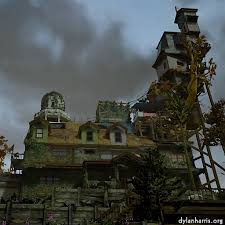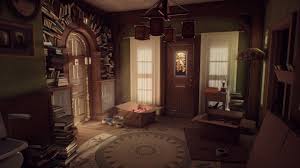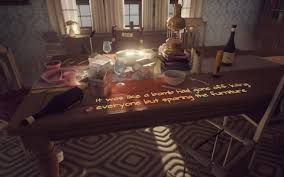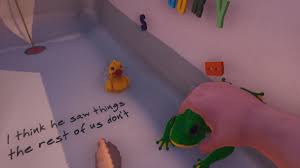 What Remains of Edith Finch is a “walking simulator for people who don’t like walking simulators,” according to designer Ian Dallas. Developed by Giant Sparrow and distributed by Annapurna on Nintendo Switch, Xbox, and Steam, it is set in an abandoned house that has many odd room additions and unusual secret passageways. In this single player game, the objective is to discover the stories of the untimely demise of various members of four generations of the Finch family. Two types of fun, narrative and exploration, are achieved through several mechanics that gradually reveal the embedded narrative: examining ephemera (diaries, pictures, and objects), walking from room to room, walking through the grounds surrounding the house, and manipulating objects (putting keys in locks, opening doors and windows, taking photographs, playing with toys, etc).
What Remains of Edith Finch is a “walking simulator for people who don’t like walking simulators,” according to designer Ian Dallas. Developed by Giant Sparrow and distributed by Annapurna on Nintendo Switch, Xbox, and Steam, it is set in an abandoned house that has many odd room additions and unusual secret passageways. In this single player game, the objective is to discover the stories of the untimely demise of various members of four generations of the Finch family. Two types of fun, narrative and exploration, are achieved through several mechanics that gradually reveal the embedded narrative: examining ephemera (diaries, pictures, and objects), walking from room to room, walking through the grounds surrounding the house, and manipulating objects (putting keys in locks, opening doors and windows, taking photographs, playing with toys, etc).

The designers use the player’s first action, opening Edith’s diary, to start the exposition of the largest narrative arc: from Edith’s return to the house to the conclusion of the final story. Embedded within this arc are smaller arcs that reveal the story of each family member.  There are very few resources in the game, but the initial one, a key that does not work in the front door, is used as an obstacle to cause the player to explore the grounds and to motivate the player to walk from room to room in search of the correct lock once inside the house. The initial rooms the player encounters are overfilled with objects but have very few manipulation points (highlighted by white dots or graphics).
There are very few resources in the game, but the initial one, a key that does not work in the front door, is used as an obstacle to cause the player to explore the grounds and to motivate the player to walk from room to room in search of the correct lock once inside the house. The initial rooms the player encounters are overfilled with objects but have very few manipulation points (highlighted by white dots or graphics). At each manipulation point, text and voice narrate something about the character it is related to. This design choice causes the player to need to explore and allows the game to give out information in very small increments. Most of the rooms are locked but have a peephole, a mechanic which the designers use to foreshadow later arcs and to introduce characters. After the first few stories have been told and the correct lock has been found, the designers make many more manipulation points available to the player to facilitate moving from room to room via “secret” passageways. This speeds up the game, as continuing to look for keys and locks could have become quite tedious. Another mechanic the designers use to tell the stories is that when a diary or other written artifact (such as a poem or a letter) is read, the player’s viewpoint shifts so that they are inhabiting a different character for the remainder of that story arc. One particularly enjoyable graphic element
At each manipulation point, text and voice narrate something about the character it is related to. This design choice causes the player to need to explore and allows the game to give out information in very small increments. Most of the rooms are locked but have a peephole, a mechanic which the designers use to foreshadow later arcs and to introduce characters. After the first few stories have been told and the correct lock has been found, the designers make many more manipulation points available to the player to facilitate moving from room to room via “secret” passageways. This speeds up the game, as continuing to look for keys and locks could have become quite tedious. Another mechanic the designers use to tell the stories is that when a diary or other written artifact (such as a poem or a letter) is read, the player’s viewpoint shifts so that they are inhabiting a different character for the remainder of that story arc. One particularly enjoyable graphic element  is the way text is used to accomplish this shift — first the text is displayed, then the voice of the new character begins to read it, the remainder of the text disappears, the point of view shifts to the new character, and then the player performs actions as that player, such as taking photographs or playing with toys.
is the way text is used to accomplish this shift — first the text is displayed, then the voice of the new character begins to read it, the remainder of the text disappears, the point of view shifts to the new character, and then the player performs actions as that player, such as taking photographs or playing with toys. In this way the designers move the player into and through each story, and embed various mini-games into the context of the stories. The only improvement to suggest is that on the Switch version it was initially difficult to figure out how to manipulate objects — some sort of tutorial embedded in the story would have helped. Otherwise, What Remains of Edith Finch was a highly enjoyable experience.
In this way the designers move the player into and through each story, and embed various mini-games into the context of the stories. The only improvement to suggest is that on the Switch version it was initially difficult to figure out how to manipulate objects — some sort of tutorial embedded in the story would have helped. Otherwise, What Remains of Edith Finch was a highly enjoyable experience.



